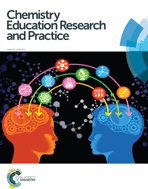Students’ interpretation and use of graphical representations: insights afforded by modeling the varied population schema as a coordination class
Abstract
Explanations of phenomena in chemistry are grounded in discussions of particulate-level behavior, but there are limitations to focusing on single particles, or as an extension, viewing a group of particles as displaying uniform behavior. More sophisticated models of physical processes evoke considerations related to the dynamic nature of bulk solutions, in which an ensemble of molecules exists with a distribution of values that vary with respect to different parameters (e.g., speed, kinetic energy, etc.). Viewing phenomena as a varied population instead of a homogenous solution has been identified as a foundational idea that is critical for reasoning in chemistry, but little work has investigated how students reason about these ideas and how instructors can support students in viewing phenomena as a distribution of states. In this qualitative study, during semi-structured interivews twelve undergraduate general chemistry students were provided with frequency distribution graphs (number of molecules vs. speed, number of molecules vs. kinetic energy) and were asked to provide explanations and make predictions. The design and analysis of this study was informed by coordination class theory, a model within the knowledge-in-pieces perspective of cognition that defines a concept as a combination of approaches for obtaining information (read-out strategies) and a cluster of knowledge elements used to draw conclusions (causal net). Framing the varied population schema as a coordination class, this work focuses on the interaction between features students attended to in distribution graphs and the ideas they discussed. Analysis indicates students have productive resources for reasoning about a varied population in general terms, but these ideas are not necessarily activated when interpreting graphs, as reflected in the students’ readout strategies. Moreover, we posit that one of the barriers toward interpreting distribution graphs was the inappropriate application of covariational reasoning. As a practical consideration, we encourage interested instructors to review the Appendix, which provides a short summary of the main findings and suggestions for practitioners.


 Please wait while we load your content...
Please wait while we load your content...